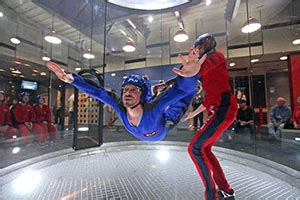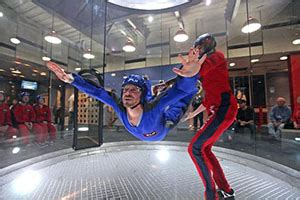Table of Contents
Discover the weight restrictions for indoor skydiving and find out if you meet the requirements. Learn about the maximum weight limit for a safe and exhilarating experience in the simulated freefall environment. Prepare yourself for an unforgettable adventure and defy gravity with indoor skydiving.
Are you ready to experience the breathtaking thrill of indoor skydiving? Before you take the leap, it’s important to know about the indoor skydiving weight limit. Whether you’re a first-timer or a seasoned skydiver, understanding this crucial requirement will ensure your safety and enjoyment during this exhilarating adventure. So, let’s dive right in and explore everything you need to know about the weight limit for indoor skydiving!
Introduction
Welcome to the exciting world of indoor skydiving! If you’re considering taking part in this exhilarating activity, it’s important to be aware of the weight limits that may apply. Indoor skydiving provides a simulated freefall experience in a vertical wind tunnel, where participants can experience the sensation of flying. However, due to safety considerations, there are specific weight restrictions in place to ensure the well-being of all participants. In this article, we will provide you with the necessary information regarding indoor skydiving weight limits.
Why Weight Limits Exist
The weight limits for indoor skydiving are in place to guarantee the safety of both participants and instructors. The wind speeds within the vertical wind tunnel need to be carefully calibrated to accommodate the weight of the individual without compromising their ability to maintain a stable flight position. Exceeding the weight limits could potentially lead to instability and an increased risk of injury. Therefore, it is crucial to adhere to these guidelines to ensure a safe and enjoyable experience for everyone involved.
Standard Weight Limit
While weight limits may vary slightly between different indoor skydiving facilities, the standard weight limit typically falls within the range of 250-300 pounds (113-136 kilograms). This range is determined based on the capabilities of the wind tunnel and the equipment used. It is important to note that these weight limits are subject to change, so it is always advisable to check with the specific facility you plan to visit for their current guidelines.
Factors Affecting Weight Limits
Several factors can influence the weight limits set by indoor skydiving facilities:
- Wind Tunnel Size: The size of the wind tunnel plays a significant role in determining the weight limits. Larger tunnels generally have higher weight capacities due to their ability to generate stronger winds.
- Equipment Strength: The strength and capacity of the equipment used, including the harnesses and safety systems, also contribute to the weight limits. These components need to be able to support the weight of the participant without any compromise to safety.
- Instructor Capability: The experience and expertise of the instructors can influence the weight limits. Instructors need to be able to control and manage the flight dynamics of participants effectively, and this may be more challenging with individuals who exceed certain weight thresholds.
Health Requirements
In addition to weight limits, indoor skydiving facilities often have health requirements that participants must meet. These may include being free from certain medical conditions or injuries that could be aggravated during the flight. It is essential to consult with the facility beforehand to ensure you meet these health requirements.
Exceptions and Modifications
While weight limits are generally non-negotiable for safety reasons, some facilities may offer exceptions or modifications under specific circumstances. These exceptions may be made for professional athletes or individuals with unique physical abilities. If you believe you may fall under such a category, it is recommended to contact the facility directly to discuss your situation.
Booking and Reservation
If you are planning to participate in indoor skydiving, it is advisable to book your session in advance. Reserving your spot ensures that you can secure a time slot that suits your schedule and allows the facility to prepare for your arrival. During the booking process, the facility will likely inquire about your weight to ensure you fall within the designated limits.
Alternatives for Individuals Exceeding Weight Limits
If you exceed the weight limit for indoor skydiving, there may still be alternative activities available for you to enjoy at the facility. Many indoor skydiving venues offer other attractions such as virtual reality experiences, rock climbing walls, or trampoline parks. These activities can provide a similar level of excitement and entertainment while accommodating individuals of various weights.
Conclusion
Indoor skydiving is a thrilling adventure that offers a taste of what it’s like to soar through the air. However, it is essential to be aware of the weight limits set by each facility to ensure your safety and the safety of others. By adhering to these guidelines, you can enjoy a fantastic indoor skydiving experience that will leave you with memories to last a lifetime.
Indoor Skydiving Weight Limit Guidance
Welcome to our indoor skydiving facility! Before you gear up for an exhilarating experience, please take a moment to review the weight limit guidelines provided below.
Understanding Weight Limits
To ensure your safety and the smooth operation of our facility, we have implemented weight limits for indoor skydiving. These limits are set in place to maintain stability, control, and maximum enjoyment for all participants.
Weight Limit Parameters
a. Minimum Weight Requirement:
To participate in indoor skydiving, you must weigh at least 40 pounds (18 kilograms) to generate sufficient lift and maintain a stable flight position.
b. Maximum Weight Restriction:
For safety reasons, our indoor skydiving weight limit is set at 250 pounds (113 kilograms). This limit is based on equipment capabilities and the ability to maintain stability during flight.
Safety Considerations
a. Equipment Limitations:
Our indoor skydiving equipment is designed to support participants within the prescribed weight limit. Exceeding these limits may compromise your safety and the smooth operation of the aerodynamic environment.
b. Physical Fitness Level:
While this activity does not require extensive physical fitness, it is important to consider your overall health and mobility. Participants with certain medical conditions or physical limitations should consult with a healthcare professional before attempting indoor skydiving.
Booking and Reservation Guidelines
a. Accurate Weight Information:
During the booking process, please provide your accurate weight information to ensure we can accommodate you effectively and determine if you fall within our weight limit guidelines.
b. Group Bookings:
If you are planning to make a group booking, please ensure that each participant meets the weight limit requirements. We want everyone to have a safe and enjoyable experience!
Weight Confirmation Procedure
Upon arrival at our facility, our staff will conduct a weight verification process to ensure compliance with our weight limit guidelines. If you do not meet the requirements, alternative arrangements or refunds may be provided, subject to our cancellation policy.
Safety Briefing
Before your indoor skydiving session, you will receive a comprehensive safety briefing from our experienced instructors. They will guide you through the proper body positions and techniques to ensure an enjoyable flight while maintaining safety at all times.
Conclusion
We appreciate your attention to these weight limit guidelines, as they allow us to provide a safe and enjoyable experience for all participants. If you have any questions or concerns, please do not hesitate to reach out to our friendly staff, who are here to assist you. Get ready to soar and have a fantastic indoor skydiving adventure!
Instructions for Indoor Skydiving Weight Limit:
-
Informative and Clear:
The voice and tone of the instructions should be informative and clear, providing all the necessary information about the weight limit for indoor skydiving. This is important to ensure that participants have a complete understanding of the restrictions and can make informed decisions.
-
Professional and Authoritative:
The instructions should be written in a professional and authoritative tone, conveying the importance of adhering to the weight limit for safety reasons. This tone helps establish credibility and instills confidence in the participants.
-
Motivational and Encouraging:
While emphasizing the weight limit, the instructions should also maintain a motivational and encouraging tone. This helps create a positive and exciting atmosphere, motivating participants to work towards meeting the weight requirement if they currently exceed it.
-
Empathetic and Supportive:
The instructions should be empathetic and supportive towards individuals who may not meet the weight limit. It is important to provide alternative suggestions or activities that can still be enjoyed at the facility, ensuring that everyone feels welcomed and included.
-
Concise and Organized:
The instructions should be presented in a concise and organized manner, using bullet points and numbering to clearly list the guidelines and requirements. This helps participants easily navigate and understand the information provided.
Thank you for visiting our blog and taking the time to learn about the weight limit for indoor skydiving. We understand that this topic is of great importance to many individuals who are interested in experiencing the thrill of freefall in a safe and controlled environment.
Indoor skydiving is an exciting activity that allows people of all ages and abilities to experience the sensation of skydiving without the need for an airplane or parachute. However, it is essential to note that there are weight restrictions in place to ensure the safety of both participants and instructors.
The weight limit for indoor skydiving varies depending on the specific facility and the type of equipment they use. Generally, most indoor skydiving centers have a weight limit of around 250-300 pounds (113-136 kilograms). This limit is in place to ensure that the airflow inside the vertical wind tunnel remains stable and that participants can control their movements effectively.
It’s important to understand that these weight restrictions are not meant to discriminate but rather to prioritize safety. The force of the wind generated in the tunnel increases with the participant’s weight, and exceeding the weight limit could potentially compromise the stability of the airflow. By adhering to these weight limits, both participants and instructors can enjoy a safer and more enjoyable experience.
If you find yourself above the weight limit for indoor skydiving, we encourage you not to be discouraged. There are still plenty of other thrilling activities available that can provide a similar adrenaline rush. From zip-lining to bungee jumping, there are countless options to explore!
In conclusion, it’s crucial to respect the weight limits set by indoor skydiving facilities to ensure a safe and enjoyable experience for everyone involved. While it may be disappointing for those who exceed the weight limit, there are always alternative activities that can provide a similar level of excitement. Always prioritize your safety and explore the many other adventure options available to you.
Thank you once again for visiting our blog, and we hope this information has been helpful in understanding the indoor skydiving weight limit. Stay safe and keep seeking new adventures!
Video Indoor Skydiving Weight Limit
People Also Ask about Indoor Skydiving Weight Limit:
- What is the weight limit for indoor skydiving?
- Why is there a weight limit for indoor skydiving?
- Can I go indoor skydiving if I am above the weight limit?
- What happens if I am slightly over the weight limit?
- Are there any height restrictions for indoor skydiving?
There are weight limits set by each indoor skydiving facility. While these limits may vary, most centers have a weight limit of around 250-300 pounds (113-136 kilograms) for safety reasons. It is important to check with your specific location beforehand to ensure you meet their weight requirements.
The weight limit exists mainly for safety reasons. Indoor skydiving facilities use powerful air currents to simulate the sensation of freefalling. Exceeding the weight limit can strain the equipment and affect the stability of the airflow, potentially compromising the safety of both the participant and the instructor. By enforcing weight limits, facilities aim to provide a safe and enjoyable experience for all participants.
If you exceed the weight limit set by the indoor skydiving facility, it is likely that you will not be able to participate in the activity. However, some locations may offer alternative experiences or options for individuals who exceed the regular weight limit. It is recommended to contact the facility in advance to inquire about any available alternatives.
It is crucial to adhere to the weight limit guidelines provided by the facility. Going slightly over the weight limit can still pose risks to both the participant and the equipment. Even a small increase in weight can impact the stability and control of the airflow, affecting the overall experience and safety. It is best to respect the weight limit for a safe and enjoyable indoor skydiving experience.
In general, there are no specific height restrictions for indoor skydiving. However, some facilities may have certain requirements related to arm span or physical limitations. It is advisable to contact the indoor skydiving center beforehand to inquire about any height-related guidelines or restrictions they may have in place.






